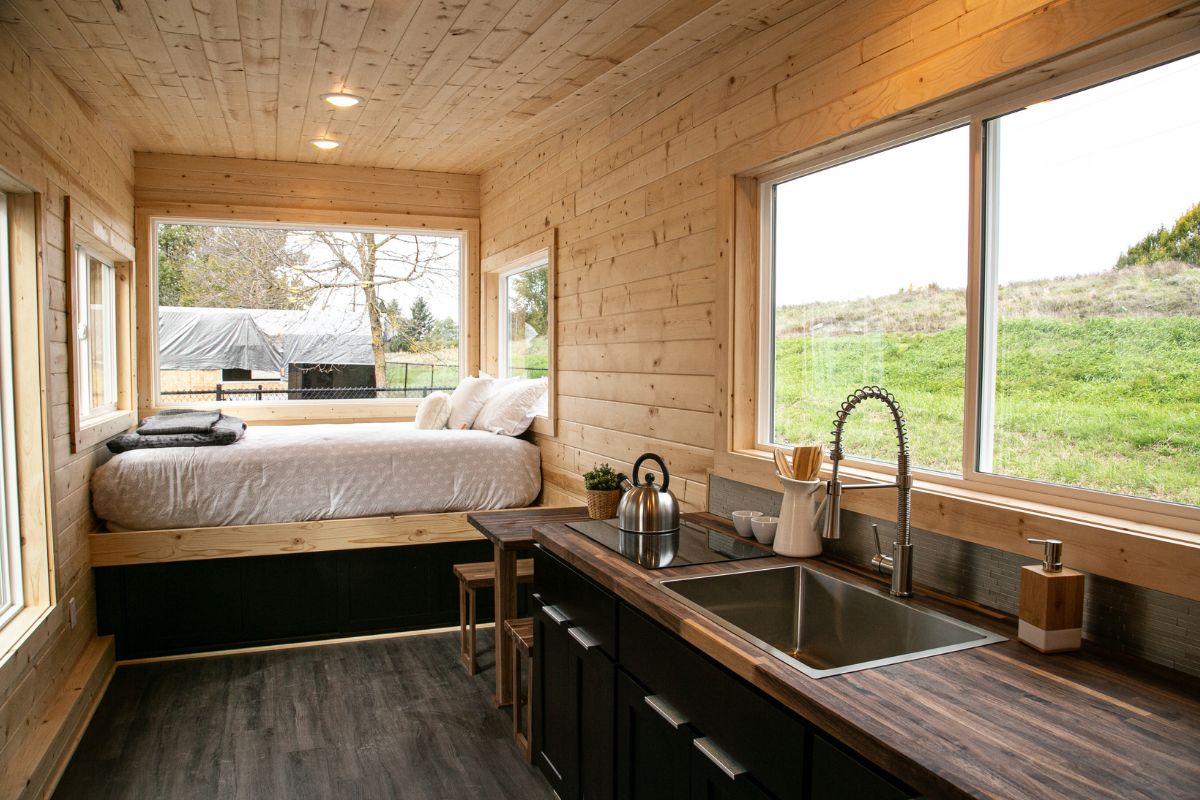Photo by New Frontier Tiny Homes
Vertical living is an increasingly popular trend among tiny house dwellers, utilizing lofts to maximize the limited space of a small home.
This article provides an overview of the advantages and disadvantages that come with incorporating a loft into a tiny house, as well as ideas for designing and creating a functional and aesthetically pleasing loft space.
This article will also discuss some innovative solutions to save space within the bedroom area in order to create an open-concept floor plan. By understanding how to embrace vertical living within these small homes, it is possible to make the most of limited spaces while still expressing personal style and promoting feelings of autonomy.
Advantages of Lofts in a Tiny Home
Utilizing lofts in a small home can provide a number of unique benefits. A tiny house plan with a loft can be an excellent way to make the most of limited space and create an additional living area that is both functional and visually appealing.
This minimalist bedroom concept allows for efficient use of vertical space, while also offering a cozy sleeping area that is separate from the main living areas. These lofts can be designed to include storage solutions, such as closets or even shelving, making it easier to keep items organized and out of sight.
In addition, many tiny homes have decks or balconies on the upper levels in order to take advantage of outdoor views and natural lighting.
When considering a tiny house plan with a loft, there are numerous design options available based on the homeowner's needs. For example, if one desires more privacy in their sleeping area they may choose to install walls between the loft and other rooms or add curtains for added separation. Other designs might include built-in desks or shelves for office work or hobbies, skylights for better illumination during daytime hours, or even custom furniture pieces crafted from lightweight materials like bamboo or rattan. By utilizing these creative approaches homeowners can truly maximize their interior space while still achieving a comfortable aesthetic throughout their home.
Incorporating a loft into one's tiny house offers great potential when it comes to optimizing both form and function within the limited square footage. Not only does this provide an extra sleeping area but it also allows homeowners to create unique living spaces that reflect their personal style without having to sacrifice comfort or convenience in any way.
Disadvantages of Lofts in a Tiny House
The utilization of a loft in a small residence can have its drawbacks, such as the feeling of claustrophobia akin to being stuck in a sardine can. The lack of space for standing and maneuvering around the loft may also be an issue for some, as it is often difficult to find furniture that fits into tight spaces. Furthermore, there is the potential for increased noise from above due to foot traffic or activities, which can be especially bothersome if one desires more privacy and solitude when living in close quarters.
With these cramped conditions, many may feel confined and unable to take advantage of their freedom. This sense of entrapment might lead to feelings of uneasiness and frustration, particularly if the individual enjoys having large spaces to move about freely without bumping elbows with others. Additionally, high ceilings are usually not possible with lofts given the limited vertical space available in tiny houses; thus making it harder for people who are tall and require more headroom.
Though lofts provide much-needed extra storage space and sleeping arrangements within a small home, they do create additional challenges that must be taken into account before deciding whether this type of accommodation is suitable for an individual's needs. It is important to remember that embracing vertical living requires adjustment on both physical and emotional levels while considering the pros and cons associated with such living arrangements.
Can I build a loft in my house?
Constructing a loft in one's home can be an attractive and cost-effective way to maximize space, but it is essential to consider the potential pitfalls of such an endeavor.
Before committing to such a project, it is important to evaluate the existing structure and determine if it is capable of supporting additional weight. Additionally, local codes may dictate the construction requirements for lofts, including maximum height restrictions or placement of guardrails or safety netting. It is also necessary to assess whether there are any obstacles that could prevent access or use of the loft area; these include low ceilings, narrow stairs, or lack of storage space.
Furthermore, one should ensure they have all the necessary tools and materials on hand before beginning construction. This includes ladders for reaching high areas for the installation of support beams as well as saws and drills for cutting holes in walls and floors. Having knowledge of basic carpentry skills will also be helpful in ensuring the successful completion of this task.
Finally, even with proper planning and preparation, constructing a loft can still present unexpected challenges that may delay completion time or require modifications during construction.
Given these considerations, building a loft into one's home can be a rewarding experience but requires a thorough evaluation before embarking on such an undertaking. The proper research regarding local building codes and resourcefulness when navigating any surprise hurdles will help ensure that this project results in increased living space without compromising safety standards or incurring unnecessary costs due to mistakes made along the way.
How tall is a loft bedroom in a tiny house?
Height restrictions for loft bedrooms in tiny houses vary according to local building codes. Generally, these limits are determined by ceiling height, which is typically between 7 and 8 feet. The average height of the bedroom floor should not exceed 6 feet from the ground. Moreover, local regulations may also require that at least one window be situated in a loft bedroom to provide ventilation and natural light as well as a means of escape in an emergency situation. Most importantly, before constructing a loft in any tiny house it is essential to check with local authorities about what the exact requirements are for building code compliance.
The size of the loft space will depend on how much room is available within the existing walls of the tiny house. It's important to consider all factors such as headroom, insulation needs, ventilation/air flow considerations, and even structural integrity when deciding on size and construction materials for a loft bedroom in a tiny home. The support beams used should be strong enough to hold up both the weight of people sleeping or walking around inside while also being able to withstand wear over time due to settling or other environmental factors like temperature changes or moisture levels.
The benefits of having a loft bedroom can include increased privacy since they're usually located away from living spaces below; improved storage solutions since items can be stored beneath beds or furniture in lofts; and enhanced safety since there's often less traffic above than on lower floors where people tend to congregate more often. However, it's important to remember that this type of bedroom must meet certain criteria set forth by local governing bodies regarding size and safety before construction begins so there are no surprises down the road when attempting occupancy permits or inspections later on down the line.
Designing Your Tiny House Loft
Designing a tiny house loft can be an exciting project that allows for creative solutions to maximize the available space while adhering to local regulations. The challenge lies in balancing the need for functional furniture and storage with the desire for natural light, ventilation, and comfortable living spaces. Careful consideration must also be given to the placement of walls, ceilings, windows, and other elements such as electrical wiring and plumbing.
With thoughtful planning and expert craftsmanship, a tiny house loft can be transformed into a cozy retreat that provides both practicality and style.
When it comes to deciding on dimensions for a tiny house loft bedroom, consider matching it with ceiling heights in other parts of the home which are typically 8 feet or less. This will help create visual continuity throughout your home as well as keep costs down by avoiding having to build taller walls or install higher ceilings. Additionally, when selecting furniture pieces for your tiny house loft bedroom remember that low-profile designs are generally best so they don't take up too much precious floor space.
Finally, incorporate creative design elements such as built-in shelving or under-bed storage compartments to further maximize available space without sacrificing comfort. When designed thoughtfully and with attention to detail, even small areas can become inviting living spaces that inspire relaxation while also providing ample room for all of your belongings.
Space-Saving Bedroom Ideas
Utilizing creative solutions, such as multi-functional furniture and hidden storage compartments, can help to maximize the available space in a bedroom while providing an aesthetically pleasing environment. Incorporating a loft bed into a tiny house is a great way to make use of vertical space while still having the functionality of two levels. Loft beds can be customized to fit any style or size of the room. Furthermore, they are relatively easy to construct and install with minimal tools and materials required.
In addition, utilizing wall shelving units or floating shelves for books and other items can free up valuable floor space in the room. Under-bed storage drawers are also great for storing clothing and other items that would otherwise take up precious floor area.
Another effective way of saving space in bedrooms is by adding window seats with built-in storage underneath them. Window seats provide extra seating without taking up valuable floor area, while also providing additional storage opportunities for blankets or pillows that don't need to be stored away every day. Aside from this, incorporating foldable desks or tables into the design can provide a convenient workspace without taking up much floor space when not in use. Decorative mirrors can also be used to create an illusion of more open space within the bedroom.
Utilizing lighter hues when painting walls will also help create an airy atmosphere which will make it feel less cramped than dark colors might do otherwise. Brightly colored textiles like curtains and bed linen can further enhance this spacious feeling in tight spaces such as tiny houses with lofts bedrooms. With careful planning and creative ideas, even small bedrooms can become comfortable living spaces worth embracing!
Conclusion
Living in a tiny house with a loft can provide many advantages. From space-saving bedroom ideas to open-concept floor plans, vertical living can be both comfortable and aesthetically pleasing.
However, there are some drawbacks as well. It is important to consider the height of your loft and if it is possible to build one in your home before making any decisions.
Nonetheless, embracing vertical living through a tiny home loft can be an entertaining way to maximize space while still enjoying the comforts of home. With careful thought put into design and planning, anyone can make their tiny house dreams come true - no matter how small they may be!






Share: